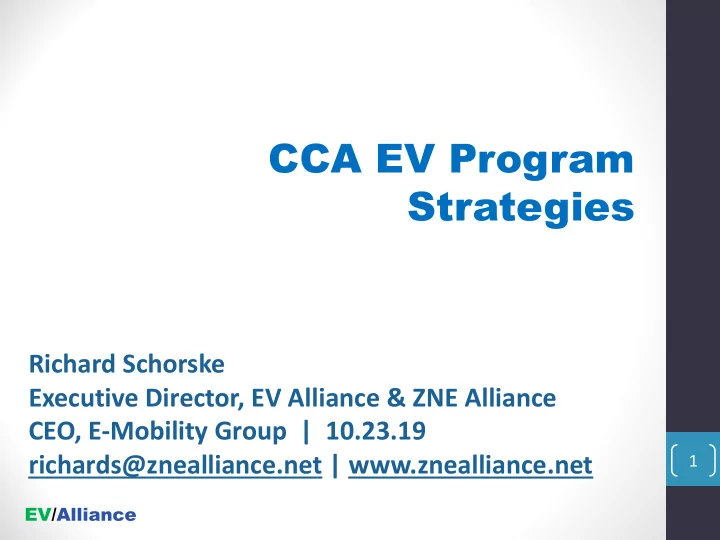

CCA EV Program Strategies Richard Schorske Executive Director, EV Alliance & ZNE Alliance CEO, E-Mobility Group | 10.23.19 richards@znealliance.net | www.znealliance.net 1 EV/Alliance
EV Alliance Mission § Founded 2009 to accelerate mass adoption of EVs § Focused on EV planning, infrastructure, fleets, & market acceleration § Clients and partners: CCAs, local governments, EV industry leaders CCA EV Plans Silicon Valley Clean Energy, Lancaster Choice Energy (ongoing) § City & Regional EV Action Plans San Francisco, Monterey Bay Area, Central Coast, Richmond § Port of Long Beach, Ventura County, Kingdom of Jordan § Best Practice Guidance § Ready, Set, Charge California! Guide to EV-Ready Communities § Linking EVs, Fast Chargers, & Storage to the California Grid 2 § Bay Area MUD Strategies for EV Charging and EV Deployment EV/Alliance
EV Alliance EV Infrastructure Project Leadership § Bay Area EV Project (400+ ports in 23 cities) § Bay Area & Central Coast Charge Ahead Projects (70+ EV ports) EV Market Acceleration § Established California Network of EV Coordinating Councils § Co-Founded Bay Area EV Strategic Council § Bay Area Experience Electric Ride & Drive Campaign (6000 drives) E-Fleet Projects § E-Fleet Accelerator – tech assistance for fleet electrification § California E-Bus to Grid Integration Project (Antelope Valley Transit) 3 EV/Alliance
Evolution of CCA EV Programs INITIAL Pro Con Trend FOCUS EVSE • Easy to administer • Limited adoption • Continuing but Residential • Builds on existing impact per $ w/ differentiated Incentives customer relationship • Lots of other focus (e.g. low & Vehicle • Reduces cost barriers players (IOUs, income, MUDs) Incentives to EV ownership APCDs, CARB) NEW FOCUS Multi-Unit • Targets under-served • More complex • More CCAs, IOU, Development segment with large • Higher cost per State $ for MUD (MUD) growth potential (50% port deployed • Can be combined Incentives for of residents in MUD) • T.A. required w/ shared EVs EVSE • Can link to building • Longer time to • Shared EVSE decarb, solar/storage impact reduces unit cost Fleets • Provides more GHG • Scaled funding • IOU make readies reduction per $ needed for over-subscribed • High-visibility impact upgrade costs • Products ready in 4 w/public & TNC fleets • Hands-on T.A. 2020+ • VPP potential (esp. very important • “As a service” EV/Alliance with e-School Buses) • Not cookie cutter models emerging
Overview of Leading CCA EV Programs Sonoma Clean Power EVSE Incentive § SCP pays for residential EVSE, customer pays tax & installation § Requires upgrade to EverGreen 100% renewable service EV Incentive § $2K standard incentive & $3500 for CARE customers § Negotiated discounts with 7 OEMs & dealers § Used EV incentives ($1K vs. $2K CARE) GridSavvy Program • Aggregates mg’t of smart thermostats, DERs, & EVSE • Vision is to bid aggregated resources into the wholesale market – including DR, day-ahead, frequency, etc. 5 EV/Alliance
Overview of Leading CCA EV Programs Peninsula Clean Energy § MUD program with in-depth assistance for owners § $1k EV Incentives with adder for low-income households w/ CBOs § Rebates in range of $3000/EVSE for 2020 (public) § Extensive Ride and Drives with REACH strategies – 12% conversion to purchase in 6 months § Fleet program in development § Substantial ($8M+) program of ratepayer investment with $12M CAL-eVIP contribution 6 § EV key to decarb – large ratepayer investment EV/Alliance
Overview of Leading CCA EV Programs SVCE MUD Program Design Goal: Increase Cost-Efficient EV Charging in Garden Apartmen ts Program Design Provide site planning assistance for property owners – including load studies • Focus initial technical assistance on 40 large properties w/ 10,000 units (larger • garden units were least coast to serve) Provide substantial incentives for near 100% cost coverage • Theory of Action With intensive T.A. and 100% incentive, many owners will install EVSE • Once charging is in place, EV adoption will increase • As EV-ready apartments become more common, renters will demand them • CCA participation can be a difference-maker, as IOU & state efforts lag • Investment $225K for site plans in Year 1+ for ~12 large buildings • 7 $4.5K to $15K per port – with lower cost per EV served w/ shared approach • EV/Alliance
How Can Cities & CCAs JointlyAccelerate EV Deployment? 1. Establish CCAs As Hub for EV Action: Organize regionally to develop competitive proposals for EV Infrastructure from CEC (CAL-eVIP), CARB, APCDs. CCAs can & should be EV planning hub. 2. Provide incentives for EVSE deployment in MUDs in tandem with aggressive new MUD EVSE requirements, e.g. 20% EV Ready 3. Integrate Climate & EV Messaging & Recognition - “Electrify Everything” campaign with Climate Emergency Mobilizations and Leadership Recognition can build support for Decarb & EV 4. Set robust public fleet electrification targets with electric School and Transit Buses as a priority target (visibility & public health) 5. Launch E-Fleet Accelerator program and engage leading private operators w/ robust targets (e.g. 50% electric by 2025) 6. Sponsor large-scale & ongoing Ride & Drive events with leading 8 employers at major venues EV/Alliance
CCAs and Cities Advancing E-Mobility Together! 1. To solve for congestion -- focus on micro-mobility & sharing • Shared E-Bikes (with bike lane improvements) • Shared E-Scooters and EVs 2. To solve for emissions -- focus on: • E-Buses (school & transit) • E-Trucks 3. To solve for equity -- focus on: • School & transit bus electrification • MUD charging – w/ electrification, solar, and storage • EV car share with MUDs (e.g., Envoy model) • Facilitate used EV purchases (w/ AQMDs, CARB) • Prioritize electrification of taxis and TNC vehicles (uber/Lyft) 9 • Provide “adder” for rebates to full-time TNC drivers EV/Alliance
Thank You! richards@ZneAlliance.net 10 EV/Alliance
Recommend
More recommend